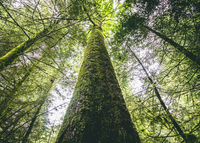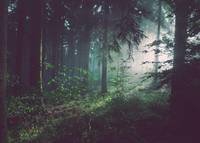Have you hugged a tree this week?
September 22 marks the 10th anniversary of National Tree Day in Canada. This annual celebration of our tall green friends always falls on the Wednesday of National Forest Week, which runs from September 19 to 25 this year and has a theme of “Our Forests—Continually Giving.”
When you consider just how many benefits trees do give us—from providing food to releasing oxygen to removing carbon dioxide from the air—it’s only natural for us to want to give back. Here are a few ways you can.
- Plant a tree. This could mean a pine tree in your yard, a small citrus tree on your apartment’s balcony or even a redwood that will eventually tower over a public park (if you can get the right permissions from the park first). Some trees are especially good at attracting bees and other pollinators, including maples and fruit trees.
- Make your trees appealing to birds by hanging a feeder and filling it regularly with high-energy oil seeds such as sunflower and canola.
- Read Finding the Mother Tree: Discovering the Wisdom of the Forest. Written by forest ecologist Suzanne Simard, the book delves into the fascinating and surprisingly sophisticated world of trees. While you’re at it, also check out Simard’s TED Talk, How Trees Talk to Each Other, which has been viewed more than 5 million times.
- Visit your favourite tree. One popular choice is the Hollow Tree, an enormous western red cedar stump in Vancouver’s Stanley Park that dates back approximately 800 years. It’s so huge that an elephant once posed inside it. When the city wanted to tear it down after a windstorm in 2006, passionate Vancouverites fought back—and won. Other crowd-pleasers include the Moon Trees all around the United States. These loblolly pine, sweet gum, redwood, Douglas fir and sycamore trees have all grown from seeds that were carried on board Apollo 14 in 1971 and used for scientific experiments in outer space.
 Photo by Jeremy Wermeille on Unsplash
Photo by Jeremy Wermeille on Unsplash - Donate to a charity that is working to protect forests and trees, such as Tree Canada, National Forest Foundation or Rainforest Trust.
- Try shinrin-yoku. This Japanese concept translates to forest bathing or forest therapy. In essence, it means to mindfully connect to nature by visiting a forest and paying full attention to everything: sights, sounds, smells, textures. It’s different from (and yet similar to) meditating or hiking in the forest.
- Read The Lorax to a child. This Dr. Seuss classic from 1971 tells the story of a greedy businessman who destroys a whole forest in order to sell useless, meaningless products. He ignores all the warnings from the Lorax, who speaks on behalf of the trees. Filled with Dr. Seuss’s trademark tongue-twisting rhymes, the beloved book was decades ahead of its time, teaching kids about saving the environment in a non-preachy way.
- Let a tree inspire you to create a piece of visual art, such as a drawing, painting or sculpture. Try to work in some leaves, branches, pinecones or acorns that you find on the ground. Or perhaps a tree could inspire your next song, story, video or photograph.
 Photo by Sebastian Unrau on Unsplash
Photo by Sebastian Unrau on Unsplash - Watch The Hidden Life of Trees. Based on the book of the same name by German forester Peter Wohlleben, the 2020 documentary examines how trees communicate, think and work together.
- Visit a spectacular forest. A few suggestions: Tongass National Forest in Alaska, which boasts glaciers, bears and trees up to 800 years old; Pisgah National Forest and Nantahala National Forest in North Carolina, which have gorgeous displays of red, orange and yellow fall foliage; and Cibola National Forest in New Mexico, which is filled with stunningly beautiful isolated mountain ranges surrounded by grasslands.
- Learn more about trees, whether that means how to identify the ones growing in your neighbourhood or how to reduce the risk of forest fires. Preventing forest fires is more important than ever, now that climate change has made the fires more commonplace—and more ferocious.
- Participate in one of the community celebrations for National Tree Day happening in 12 cities across Canada on September 22.


